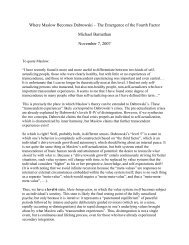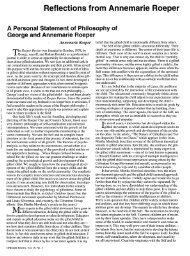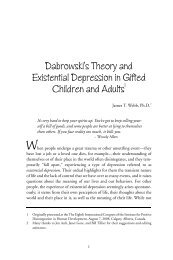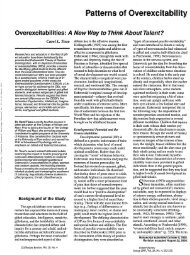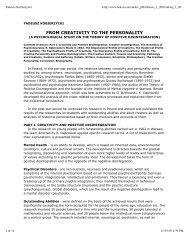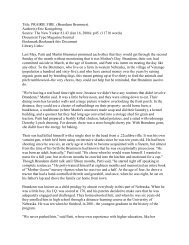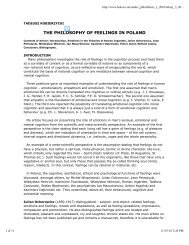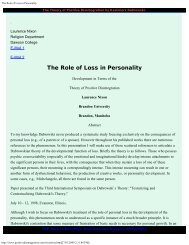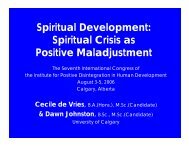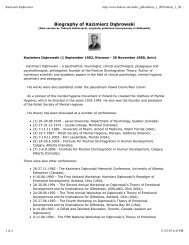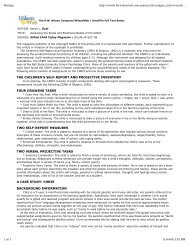Strategies Used by Intellectually Gifted Students to Cope With Stress ...
Strategies Used by Intellectually Gifted Students to Cope With Stress ...
Strategies Used by Intellectually Gifted Students to Cope With Stress ...
Create successful ePaper yourself
Turn your PDF publications into a flip-book with our unique Google optimized e-Paper software.
130 <strong>Gifted</strong> Child Quarterly 54(2)<br />
general education shared facilities and faculty. A <strong>to</strong>tal of 141<br />
students in the IB program gained parental consent, provided<br />
written assent, and then completed the surveys.<br />
Based on information obtained from school records, researchers<br />
classified participants as gifted (n = 52), or high-achieving<br />
IB students (n = 89). The state’s identification criteria for intellectual<br />
giftedness includes (a) individual IQ score of two<br />
standard deviations or higher, (b) need for specialized educational<br />
services, and (c) majority of gifted behaviors exhibited<br />
according <strong>to</strong> a standard checklist (Florida Department of Education,<br />
2008). Of the 52 gifted youth, 11 were admitted under<br />
“Plan B” such that they were identified as gifted on criteria<br />
other than IQ score. Of the 41 students identified through the<br />
state’s traditional mechanisms (i.e., superior performance on<br />
standardized tests of intellectual functioning), full scale or composite<br />
IQ scores obtained during the individual psychoeducational<br />
assessment conducted for eligibility determination ranged from<br />
117 <strong>to</strong> 149 (M = 133.54, SD = 6.38). Specific information<br />
regarding the demographic characteristics (grade level, gender,<br />
ethnicity, socioeconomic status [SES] as assessed <strong>by</strong> qualifying<br />
or not for free/reduced-price school lunch) of the gifted and<br />
high-achieving IB youth who participated in this phase of the<br />
research is included in Table 1. Both gifted and high achieving<br />
study participants met rigorous IB school admission criteria,<br />
including teacher recommendations, strong writing ability as<br />
evidenced on an application essay, and a his<strong>to</strong>ry of promising<br />
academic achievement in middle school coursework.<br />
School records did not contain information about the cognitive<br />
abilities of the high achieving students (presumably because<br />
they had not participated in earlier district-conducted psychoeducational<br />
evaluations <strong>to</strong> assess for intellectual giftedness),<br />
thus it is unknown if students in this subgroup had similar cognitive<br />
abilities but perhaps simply had not been evaluated for<br />
eligibility for gifted education or had been screened but not<br />
identified for intellectually gifted services. <strong>With</strong> regard <strong>to</strong> academic<br />
achievement, mean weighted grade point averages<br />
(GPA) for the two subgroups were statistically similar, t (139)<br />
= .46, p = .64, indicating that both gifted and high-achieving<br />
students excelled in their academic coursework (GPA: M =<br />
4.11, SD = .39 for the gifted sample; M = 4.15, SD = .38 for the<br />
high-achieving IB sample) during the year in which they <strong>to</strong>ok<br />
part in the current study.<br />
The following year, 8 focus groups were conducted with 48 of<br />
the original 141 survey participants, including 22 gifted (4 focus<br />
groups) and 26 high achieving (4 focus groups) learners. As<br />
shown in Table 2, students in the focus groups were from Grades<br />
10 <strong>to</strong> 12, represented both genders, and were predominately Caucasian.<br />
During the focus groups, students were asked <strong>to</strong> describe<br />
how they responded <strong>to</strong> stress, and then asked <strong>to</strong> specify which<br />
strategies they viewed as helpful as well as those reactions that<br />
did not seem <strong>to</strong> help (i.e., were ineffective ways <strong>to</strong> cope).<br />
Measures and Indica<strong>to</strong>rs<br />
Perceived <strong>Stress</strong> Scale. The original Perceived <strong>Stress</strong> Scale<br />
(PSS; Cohen, Kamarck, & Mermelstein, 1983). PSS assessed<br />
both stress and coping with 14 items. As a more comprehensive<br />
assessment of coping was used in the current study (see<br />
below), only the six items from the PSS that were identified<br />
in an earlier explora<strong>to</strong>ry fac<strong>to</strong>ry analysis (Golden-Kreutz,<br />
Browne, Frierson, & Anderson, 2004) as indicative of perceived<br />
distress were used in the current study <strong>to</strong> measure<br />
student perceptions of stress. Respondents rate the degree<br />
they find their lives <strong>to</strong> be “unpredictable, uncontrollable and<br />
overloading” (Cohen et al., 1983, p. 387) according <strong>to</strong> a<br />
5-point Likert-type scale. Specifically, respondents consider<br />
their experiences in the prior month and rate from 0 (never)<br />
<strong>to</strong> 4 (very often) how often they felt, for instance “difficulties<br />
were piling up so high that you could not overcome them,”<br />
“nervous and stressed,” and “unable <strong>to</strong> control the important<br />
things in your life.” In line with the global nature of the items,<br />
the PSS purports <strong>to</strong> measure general stress rather than stress<br />
perceived from a particular demand, such as school.<br />
Though there are multiple understandings of stress, in the<br />
PSS, stress is conceptualized as a transactional construct, or<br />
based on how an individual perceives stressors as well as the<br />
nature of the stressor (Galaif et al., 2003). Correlations between<br />
global objective measures of stress and the PSS are relatively<br />
small (.17 <strong>to</strong> .39), and moderate relationships with event impact<br />
(.24 <strong>to</strong> .49) and prediction of depression and health challenges<br />
(.65 <strong>to</strong> .76) in comparison with objective stress assessments<br />
(.14 <strong>to</strong> .18) have been documented (Cohen et al., 1983).<br />
Adolescent Coping Orientation for Problem Experiences. Initially,<br />
coping was assessed through the Adolescent Coping<br />
Orientation for Problem Experiences (ACOPE; Patterson &<br />
McCubbin, 1981 as cited in Patterson & McCubbin, 1987), a<br />
54-item self-report coping inven<strong>to</strong>ry designed <strong>to</strong> identify the<br />
behaviors that adolescents use most frequently <strong>to</strong> manage<br />
problems presented <strong>by</strong> difficult situations.<br />
Although the ACOPE was originally intended <strong>to</strong> identify<br />
12 coping styles, a four-fac<strong>to</strong>r solution identified reliably with<br />
multiple samples of youth (e.g., Fanshawe & Burnett, 1991;<br />
Howard & Medway, 2004) was used in analyses in the current<br />
study. These four separable ways of coping include responding<br />
<strong>to</strong> stress via the following strategies: positive appraisal (view<br />
a stressful situations in a positive light or focus on friendships),<br />
negative avoidance (use of alcohol, cigarettes, or drugs),<br />
family communication (seeking advice from, and harmonious<br />
relationships with, family members), and anger (complaining,<br />
blaming, and/or yelling). For des criptions of the specific<br />
ACOPE items included within each coping style, see Suldo,<br />
Shaunessy, and Hardesty (2008).<br />
Results<br />
Research Question 1: Do intellectually gifted learners<br />
experience diminished or elevated levels of perceived<br />
stress compared <strong>to</strong> other students in the IB program?<br />
The global stress levels (i.e., mean score on the PSS) of<br />
two groups of students in the same IB program were compared.<br />
The “gifted group” consisted of the 52 students who<br />
Downloaded from gcq.sagepub.com at UNIV CALGARY LIBRARY on March 4, 2011



